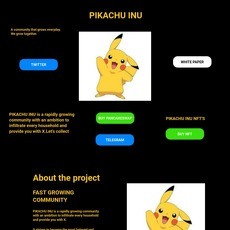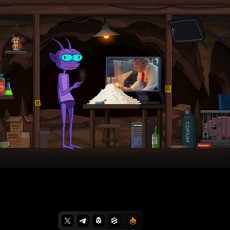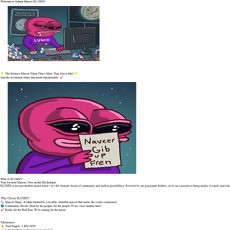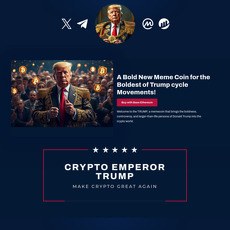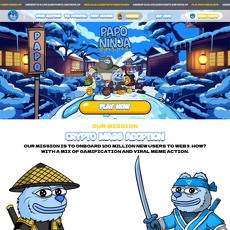CADAICO Review
CADAICO
cadai.co
If your website is on the scam list and you think that you are not a scammer, contact us. After you provide us with all the proof that you are in Crypto World with good intentions, we will delist you. Usually, you get in this category because you are hiding your team, you have a bad reputation(you are tricking, deceiving, scamming people), and you haven't got a written project whitepaper or is a shitty one....
Their Official site text:
The Engineering Revolution is Here.
Whitepaper.
Version 1.5
February 2024
www.cadai.co
1
Table of Contents
Abstract.............................................................................................................................................. 3
1. Why CADAICO................................................................................................................................4
1.1. The Problem............................................................................................................................4
1.2. The Solution............................................................................................................................... 6
2. The CADAICO Technology Stack.......................................................................................................7
2.1. The CADAI Platform: Opening up to Innovation..................................................................... 8
2.2. The CADAI Model: The Innovation Engine............................................................................ 9
2.3. The CADAICO Blockchain: Trust, Transparency, and Efficiency.......................................... 10
3. The CADAI Assistant: Our Flagship Application.............................................................................12
4. Use Cases for Applications on the CADAI Platform.......................................................................15
4.1. 3D Printing App.....................................................................................................................15
4.2. Electronic Parts.....................................................................................................................15
4.3. Medical Prototyping...............................................................................................................15
4.4. Sustainable Design & Manufacturing....................................................................................16
4.5. Education & Training.............................................................................................................16
4.6. Architecture & Construction.................................................................................................. 16
4.7. Automated Quality Controls.................................................................................................. 16
4.8. Automotive & Aerospace Industries......................................................................................16
4.9. Fashion & Apparel.................................................................................................................17
5. The CADAI Token............................................................................................................................... 17
5.1. CADAI Token Design............................................................................................................ 17
5.2. CADAI Token Distribution & Emission Schedule.................................................................. 20
6. Business Model................................................................................................................................ 22
6.1. Market Outlook.........................................................................................................................22
7. The Roadmap.................................................................................................................................... 25
8. Team & Advisors............................................................................................................................... 26
8.1. Our Advisors......................................................................................................................... 27
Glossary............................................................................................................................................27
Disclaimer.........................................................................................................................................29
Appendix...........................................................................................................................................31
2
Abstract
The engineering field has undergone a profound transformation with the advent of
Computer-Aided Design (CAD), becoming an integral part of an engineer's daily life. However,
despite technological progress, the CAD engineering process still grapples with inefficiencies.
Manual design processes drive up engineering costs, limited interoperability between CAD
systems hinders engineering productivity growth and the lack of transparency regarding existing
and potential complementary software for CAD systems slows down innovation. Additionally,
limited integration of AI technology within CAD software hampers technological progress and
efficiency, particularly in the design process of customized products, where 60-70% of costs are
attributed to engineering expenses. Root causes include manual labor reliance, underutilization
of existing CAD data, exclusive software features, and the complexity of switching CAD systems.
The CAD market is worth billions of US dollars and, with all its challenges, offers a very attractive
environment for change.
CADAICO addresses these challenges leveraging powerful AI models and blockchain technology
to deliver a CAD-focused ecosystem, the first of its kind. Our solution includes the CADAI Model, a
combination of the newest AI technologies trained on vast CAD datasets, streamlining AI use for
developers, accommodating various CAD programs, and ensuring transparency regarding
available plug-ins and applications for CAD software.
Utilizing the CADAI Model as a foundation, we are building a developer platform and marketplace
for creating and using extensive applications for future AI-based CAD assistants and tools. The
CADAI Platform empowers developers to create AI-based plug-ins for any CAD software, with the
CADAI Assistant as our inaugural offering on the CADAI Marketplace, created to enhance
engineering design efficiency. The CADAI Assistant functions autonomously within any CAD
software, offering potential annual savings of up to $1,000,000 for mid-sized manufacturing
plants.
We are taking advantage of the latest technology when it comes to information security and
transparency by using our own native blockchain driven by the CADAI token - CADAICO's native
utility token.
With a diverse revenue approach, CADAICO is poised to make a significant impact in the CAD
market, promoting efficiency, innovation, and cost savings.
3
1. Why CADAICO
1.1. The Problem
In the contemporary world of engineering and manufacturing, technology has optimized the
design process to its pinnacle. Yet, a notable obstacle persists largely unaddressed - the
inefficiencies ingrained within the computer-aided design (CAD) engineering process.
Design experts from Festo SE & Co. KG state that only 25-30% of the design process relies on an
engineer's creativity and engineering expenses constitute a significant 60-70% of production
equipment costs, a burden that affects all specialized products due to high efforts for
redesigning and the reliance on a manual labor-based system.
Even when CAD software companies introduce new features to enhance engineering efficiency,
medium and large companies are reluctant to adapt their existing CAD software systems with
each new feature release. This hesitance is underscored by the distinct functions and native file
formats inherent to each CAD software, rendering them unique and challenging to interchange.
Daimler's 5-year transition from DS Catia to Siemens NX is a prime example, involving training for
6,000 engineers, converting 230,000 CAD files, and migrating 1,000 suppliers, incurring significant
costs in the low three-digit million euros range. The process of importing and exporting CAD files,
usually a simple task, often becomes problematic due to the loss of parametric features during
3D model transfer. This results in models lacking functionality or incomplete translations with
missing surfaces. The limited ability of CAD packages to read and write in various native formats
exacerbates the issue, forcing the use of neutral formats like STEP files. Despite the capability of
major CAD/CAM packages to open part files from different systems, achieving full compatibility
remains a significant and unaddressed challenge in the CAD software industry.
Drawing from our experience and industry insight, we've pinpointed the primary sources behind
CAD industry challenges:
● The dependence on manual labor
Despite living in an era of automation and digital solutions, engineers continue to shoulder
the burden of manual design, resulting in high labor costs due to their high hourly rates,
which are around $100 for countries like Germany1
.
● Underutilisation of existing CAD data
Every engineering organization has a wealth of CAD data (between 100,000 and 500,000 CAD
files in medium and large companies) from previous projects and designs. Instead of
tapping into this goldmine, engineers often start from scratch due to a lack of knowledge about
1Glassdoor (2023): CAD Engineer Salaries in Germany
4
existing data and the time-consuming nature of manually searching through thousands of files.
It remains to be impossible to find the needle in the CAD haystack.
● CAD companies only release new features for their own CAD programs that are incompatible
with others because they want to increase their own market share. This means that companies
can't use one CAD software and combine it with new features of another CAD software.
● Switching to another CAD software is almost impossible for an engineering company due to
the high costs and effort required for the change.
● Companies need to mandate CAD partner companies to develop plug-ins for their specific
CAD program, without knowing whether such plug-ins have already been developed by
others due to a lack of transparency on the market.
● Limited integration of AI technology. The integration of AI in CAD software has so far mainly
been limited to the field of generative design, with smaller CAD partner companies having
to struggle with significant limitations. These smaller entities often need more expertise
and resources to train their AI models and develop AI-based plug-ins. This gap is evident
despite the massive growth in the technology sector, as highlighted by GlobalData's
report on Innovation in Artificial Intelligence: AI-assisted CAD2
. In the past three years
alone, the technology industry has witnessed the filing and granting of over 3.6 million
patents, underscoring the rapid advancement in this field. Yet, the specific use of AI within
CAD systems remains a challenging frontier, especially for smaller companies in the
industry.
In summary, the engineering industry is trapped in a costly and inefficient cycle where the CAD
design process is outdated. A modern, efficient solution is urgently needed - and that's precisely
where CADAICO enters the picture.
2 GlobalData (2023): Innovation in Artificial Intelligence: AI-assisted CAD
5
1.2. The Solution
We stand on the brink of a breakthrough prepared to revolutionize CAD design. However, given
the vast scope of CAD design, we cannot possibly foresee every challenge encountered in the
design processes of countless companies worldwide. Instead of attempting to tackle all these
diverse issues individually, we have devised a unique solution that harnesses the collective power
of a community to address each and every one of these challenges. Our commitment is to
transform the landscape of CAD by nurturing a pioneering ecosystem founded on collaboration
and innovation. Our innovative approach seamlessly integrates AI and Blockchain technologies,
giving rise to the world's first CAD-focused blockchain ecosystem.
A solution that…
● Uses a trained AI for CAD that can be retrained on the customer’s specific data
● Enables developers to use AI without having the trouble of AI training
● Enables software agnostic approach, as well as software-specific one
● Enables customers to stay with their preferred CAD software
● Offers full transparency about every existing CAD app on the market
We are diligently crafting a powerful platform that will enable developers to create innovative
AI-based plug-ins and applications for any CAD software, effectively addressing the diverse
challenges in the design process and contributing to a thriving CAD ecosystem. Our platform's
cornerstone is a robust AI model that's already in training, and its integrity will be strengthened by
the inclusion of transparent blockchain-based data validation algorithms. Additionally, we're in
the process of developing an AI assistant for CAD, which will be the first application available on
our marketplace. The CADAI Assistant supports engineers through the whole design process and
functions as a plug-in for any relevant CAD software like Solid Edge, Catia, or Creo while
operating independently. Furthermore, CADAICO is integrating blockchain technology to ensure
data security, integrity, and trustworthiness. The native CADAICO blockchain supports data
distribution, transaction processing, global settlement, and access management, all powered by
the CADAI token, the platform's native utility token.
1.2.1. The Impact
The CADAI Platform's transformative impact on the CAD industry is significant. To understand this,
let's consider some scenarios that illustrate the changes our solution brings.
The CADAI Platform, featuring universally accessible AI technology and plug-ins for any CAD
software, streamlines development, enhances compatibility, and accelerates AI-based
innovation. By providing trained AI models for CAD applications, CADAICO simplifies AI integration
within CAD plug-ins. This approach fosters the creation of high-quality AI-based features and
ensures their continuous enhancement and relevance in the CAD industry. CADAICO's AI-based
6
platform has the potential to reduce non-creative design processes by 70-90%, resulting in cost
savings of 30-40% and boosting engineer productivity.
2. The CADAICO Technology Stack
CADAICO's technology stack blends Artificial Intelligence and Blockchain, anchored by the
versatile AI Model customizable for specific needs. The integrated blockchain guarantees secure
transactions.
Illustration 1: The CADAICO Ecosystem: Growth Principle
7
2.1. The CADAI Platform: Opening up to Innovation
Our strong belief in the potential of open Innovation has driven us to envision an expansive
landscape filled with captivating and valuable CAD applications based on our AI technology. The
CADAI Platform represents a revolutionary and open ecosystem crafted to harness developers'
and community members' collective creativity and expertise worldwide. It stands as an
accessible and dynamic playground, driven by the innovative technologies developed by
CADAICO and made easily accessible through user-friendly APIs. This platform isn't just a hub for
innovation; it's a fertile breeding ground for pioneering applications, plug-ins, and add-ons for
CAD software, all deeply rooted in our advanced AI technology. The self-sustainability of the
CADAI Platform lies in its cyclical ecosystem, promoting a philosophy of shared growth.
Participation in this ecosystem signifies more than just individual gain; it signifies a contribution
to the collective advancement of the entire community. Creators can share their apps on our
marketplace and receive immediate, secure compensation through blockchain-powered CADAI
tokens.
Illustration 2: CADAI Platform: Working principle
2.1.1. The CADAI Marketplace: A hub of AI-based
innovation for CAD
The CADAI Marketplace stands as a pivotal component within this ecosystem. It functions as a
stage for developers to showcase their inventive creations, spanning from task-specific utilities to
all-encompassing applications capable of revolutionizing entire CAD workflows. This diverse
array of tools, residing within the marketplace, is poised to push the existing boundaries of CAD
technology. Community members receive CADAI tokens as rewards when their applications are
8
utilized by others, providing them with a tangible incentive for further innovation. These tokens
aren't just a means of compensation; they also serve as keys to unlock premium features, gain
early access to new models, or support other projects hosted on the platform.
2.1.2. The CADAI Challenge Board
Another equally crucial facet of our ecosystem is the CADAI Challenge Board. This interactive
feature empowers users and companies to articulate precise CAD challenges, inviting developers
to tackle these issues head-on. Subsequently, developers can craft tailor-made applications as
solutions offered on the marketplace for broader accessibility. We plan to organise regular
hackathons and workshops to further fuel creativity and foster collaborative problem-solving.
These events are not solely about community building; they also serve as valuable sources of
feedback, facilitating the ongoing refinement of CADAI and the overarching platform.
2.2. The CADAI Model: The Innovation Engine
At the core of our solution lies the latest machine learning technologies and AI models,
pre-trained by CADAICO, forming the bedrock of our ecosystem. The CADAI Model harnesses the
combined power of AI training technologies, several large language models and supervised
learning, operating on advanced neural networks.
In the initial machine learning phase, these neural networks undergo intensive training using an
extensive array of CAD libraries, complemented by thousands of standard engineering parts
catalogs and other pertinent design data. This foundational training equips the CADAI Model with
the knowledge and capabilities to address a broad spectrum of engineering and design tasks
right from the outset. Behind this training process lies CADAICO's innovative technology,
automatically translating pertinent data into training data comprehensible to our AI models. This
enables us to offer tailored AI training to each company, grounded in their specific relevant data.
Taking this a step further, we integrate this pre-trained neural network into a Reinforcement
Learning model. With a continuous feedback loop from users, the CADAI Model adapts by
learning from engineers' design patterns, decisions, and feedback. The more extensively the
CADAI Model is employed in the design process, the more it improves, taking on increasingly
complex tasks and expanding its capabilities. It becomes proficient at processing extensive
volumes of design data and emulating human design methods, allowing it to discern intricate
patterns, grasp relationships, and comprehend user preferences. This aptitude empowers it to
create intricate CAD models with ever-increasing accuracy.
Our objective for the AI models is to replicate the success of OpenAI in democratizing Large
Language Models (LLMs), with ChatGPT serving as a prime example. We aspire to make
engineering AI equally accessible through adaptive AI models hosted on our platform. This
9
approach fosters open innovation and an adaptable ecosystem capable of accommodating
various AI applications tailored for specific CAD use cases.
CADAICO is poised to revolutionize the design and construction industry, offering a fresh and
highly efficient approach to CAD model generation.
2.3. The CADAICO Blockchain: Trust, Transparency,
and Efficiency
While the CADAI Platform is a potent tool for open innovation, we acknowledge the importance of
fostering trust and confidence, particularly in company-specific use cases. To achieve this, we
have turned to blockchain technology to introduce an unparalleled layer of security and
transparency to our system.
Blockchain technology encompasses a unique blend of characteristics, including immutability,
transparency, and security, which are pivotal in addressing the trust deficit that often plagues AI
systems. Unlike traditional centralized databases, which are susceptible to hacking, corruption,
and unauthorized access, a decentralized blockchain network ensures that data remains
transparent and secure.
A significant challenge for business models offering AI-based services to enterprise customers
revolves around establishing trust in the underlying model. For this reason, CADAICO has opted to
construct its platform and data validation algorithms atop the ONINO Sub-Chain framework. The
CADAICO Blockchain operates on a DAG-based consensus algorithm, facilitating high throughput
and sub-2-second transaction finality. The CADAICO blockchain will fortify its security through its
consensus algorithms and validators while additionally anchoring on top of the ONINO Main
Chain, ensuring superior scalability and security for our enterprise-focused features.
Our blockchain integration introduces three key features to enhance its ecosystem. Firstly, it
ensures transparent training data, allowing users, developers, and enterprises to validate data
usage in training the CADAI Model, building trust in the model's foundation. Secondly, the
blockchain enables the creation of a transparent, secure, and instant marketplace on top of the
CADAICO Platform, providing easy access to the CADAI Models. Finally, automated access
management through blockchain-based role access control ensures secure management of
licenses and platform functions.
This blockchain infrastructure is a dependable, secure, and decentralized platform for other AI
applications that necessitate preserving the integrity of training data and ensuring safe access
to our systems. The robustness of blockchain technology fosters trust and transparency, driving
innovation and progress within the AI development community. This data integrity is particularly
10
Java
significant for the CADAI Model, guaranteeing transparency and immutability in all design
iterations, specifications, and user activities.
The CADAICO Blockchain offers a range of benefits to the AI model and the broader ecosystem. It
enhances efficiency through smart contracts that automatically validate data quality, ensuring
prompt admission of high-quality designs. Additionally, blockchain facilitates secure and efficient
data distribution and transaction settlement with cost-effectiveness and near-instant global
settlements. The use of Byzantine Fault Tolerance (BFT) algorithms ensures consensus in
multi-stakeholder environments, promoting robust and rapid settlements. Moreover, secure
access management is achieved through Role-Based Access Control (RBAC), where distinct
cryptographic key pairs and digital signatures govern permissions for various types of data
access and system administration.
The 'Proof of Training Data' algorithm is intended to securely record essential data points and
metadata on the blockchain. This encompasses details like data origin, training timestamps,
quality metrics, and AI model performance changes post-training. Smart contracts within the
blockchain validate data against predefined quality standards before it is employed for training,
assuring data integrity. Although the algorithm is undergoing testing and will only be accessible
upon the CADAI Model's release, a foundational conceptual approach is outlined below.
PROOF_OF_TRAINING_DATA(training_data, creator, metadata)
1 QUALITY_THRESHOLD ← predefined_value
2 INTEGRITY_THRESHOLD ← predefined_value
3 blockchain_record ← Ø
4 quality_score ← EVALUATE_DATA_QUALITY(training_data)
5 integrity_score ← VALIDATE_DATA_INTEGRITY(training_data)
6 if quality_score < QUALITY_THRESHOLD or integrity_score < INTEGRITY_THRESHOLD
7 then return "Data does not meet quality or integrity standards."
8 data_hash ← HASH(training_data)
9 metadata['quality_score'] ← quality_score
10 metadata['integrity_score'] ← integrity_score
11 metadata['creator'] ← creator
12 metadata['timestamp'] ← CURRENT_TIMESTAMP()
13 blockchain_record['data_hash'] ← data_hash
14 blockchain_record['metadata'] ← metadata
15 SMART_CONTRACT_COMMIT(blockchain_record)
16 return "Successfully added to blockchain."
-------------------------------------------
Function EVALUATE_DATA_QUALITY(training_data)
1 quality_score ← 0
2 // Insert custom quality metrics here
3 return quality_score
-------------------------------------------
Function VALIDATE_DATA_INTEGRITY(training_data)
1 integrity_score ← 0
2 // Insert custom integrity metrics here
3 return integrity_score
11
3. The CADAI Assistant: Our Flagship
Application
Leveraging our CADAI Model, we are developing the CADAI Assistant as a plug-in compatible with
any relevant CAD software such as SolidWorks, Solid Edge, Inventor, Catia, or Creo. This
groundbreaking tool represents the first independent AI solution for CAD, affording engineering
companies the flexibility to retain their preferred CAD program while harnessing AI's cutting-edge
capabilities. This technology will steadily enhance its performance over time by continuously
learning from accumulated training data.
Imagine being an engineer tasked with designing equipment for product assembly within your
company. Your company has a vast library of CAD files, but their sheer volume makes manual
searching impractical. You reluctantly start your CAD software and begin the painstaking process
of designing from scratch. After completing the initial design, you face the daunting task of
creating multiple versions for different product variations. Now, picture a future where you open
your CAD program and, instead of starting from scratch, you interact with the integrated chat box
to communicate your equipment design needs to the CADAI Assistant.
The CADAI Assistant rapidly generates equipment components using the company's CAD
database, standard parts catalogs, and suppliers' resources. The user has full control, selecting
and modifying parts as desired. The CADAI Assistant offers valuable suggestions throughout the
design process, fostering a collaborative dialogue until the equipment design is complete. With
each interaction, the CADAI Assistant becomes more intelligent and skilled, continuously evolving
and improving its capabilities.
At the bottom end, this means
creating innovative and
groundbreaking products at
lower cost.
The first CADAI Assistant
functions to be implemented:
1. Imagine you're an
engineer, who likes to
start a new design. The
first thing you do after
starting your CAD
software is to write the
12
Illustration 3: Schematic illustration of the CADAI Assistant
CADAI Assistant what you want to design.
You: “Today I like to design a bracket to hold a product on a workbench.”
CADAI Assistant: “Please load your product and the part you like to connect it to”
You supply the necessary data to the CADAI Assistant, which then searches your
company's CAD database and displays existing bracket designs. You can select the
parts you want to use and proceed.
2. Now you like to change the bracket to make it fit your product.
You: “Please adjust the mount to my product.”
CADAI Assistant: ”Please mark the parts of the product and mount that are in contact.”
You mark all parts in your CAD software.
You: “Done.”
CADAI Assistant adjusts the mount to the product surface.
CADAI Assistant: “Is that how you imagined it?”
You: ”Yes, thanks.”
3. Now you are finished with your rough design and like to refine the design.
You: “Hey CADAI. Could you please put in all the necessary screws?”
CADAI Assistant: “What forces affect along the axes X, Y, and Z?”
You: “Done.”
CADAI Assistant: “I would use standard screws. Is that ok?”
You: “Yes, thanks.”
CADAI Assistant: “Done.”
4. Imagine you’re designing something and suddenly the CADAI chat box pops.
CADAI Assistant: “Hello. I can see that you’re designing a part, which I might have an
existing standard part for. Do you want to see it?”
You: “Yes, please.”
CADAI Assistant shows you the part on the screen.
You: “Fits well. Please replace it in my design.”
CADAI Assistant: “Done.”
5. You just finished your design and now like to have it in 5 more sizes for different product
versions.
You: “Hey CADAI. Please scale my design and adapt it to other product variations.”
CADAI Assistant: “Alright. Please load all product variations and adjust them to your
design.”
You load all variations into the CAD software and adjust them: “Done.”
CADAI Assistant: “I’ll start the process. It will take a few minutes. Time for a coffee break?”
After a few minutes, the CADAI Assistant replies: “Done. Please review the results.”
You: “There is a collision in design no. 3. Please remove it, changing the design slightly.”
CADAI Assistant: “Done. Something else?”
You: “That’s it. Thanks.”
13
The potential for substantial cost reductions, around 30% to 40%, is a promising prospect for the
CADAI Assistant. For example, in a typical scenario where a manufacturing plant needs to design
a $100,000 piece of equipment, engineering costs can reach $60,000 to $70,000. This cost
structure is a significant concern in the engineering industry. Mid-sized manufacturing plants in
Europe usually allocate $1-3 million annually for customized equipment and special machines.
This could result in annual cost savings of $300,000 to $1,200,000 per plant.
Companies like our partner Schnaithmann Maschinenbau GmbH could see a remarkable 30-40%
boost in design team productivity, equating to annual cost savings of up to $2 million for
similar-sized companies.
14
Illustration 4: Screenshot of the CADAI Assistant proof of concept
4. Use Cases for Applications on the
CADAI Platform
In this chapter, we delve into a carefully curated collection of applications that can harness the
capabilities of our AI models. While these represent the ideas we've introduced, it is crucial to
acknowledge that the scope of CADAICO knows no bounds and extends as far as the imagination
of our vibrant community. While we concentrate on a select few use cases, they merely illustrate
the boundless potential that CADAICO can unlock rather than an exhaustive inventory.
4.1. 3D Printing App
We aim to promote 3D printing by integrating our AI model into a user-friendly application for
individuals of all CAD expertise levels. This cloud-based app allows users to effortlessly create
customized 3D models for printing. For example, you can design a bike bottle holder with a mount
for your specific air pump or a custom GoPro camera mount for your bike's handlebars. Just
provide the details, and the AI does the rest. Once your design is ready, you can download and 3D
print it.
4.2. Electronic Parts
Designing and optimising electronic components, such as printed circuit boards (PCBs),
traditionally involve highly manual and inefficient processes. The potential for streamlining
design procedures in this domain is immense. By retraining our AI models specifically for
electronic components, developers worldwide could craft diverse applications that automate
tasks related to PCB design, simulations, and optimisation. Such advancements could
significantly benefit one of the largest industries globally.
4.3. Medical Prototyping
The applications of CADAI Platform and CADAI Model in the medical field hold immense promise.
Medical professionals could swiftly devise and prototype tailor-made medical devices or
equipment pieces. For example, physiotherapists might create customized aids for their patients
using a medically specialized version of our AI models. These designs could be promptly realized
through 3D printing, resulting in personalized patient care and improved medical outcomes.
15
4.4. Sustainable Design & Manufacturing
In the sphere of sustainable design and manufacturing, the CADAI Model has the potential to
analyze designs for enhanced resource efficiency. Optimizing material usage and reducing
waste could play a pivotal role in aiding businesses in achieving their sustainability objectives.
This not only minimizes environmental impact but also leads to long-term cost savings.
4.5. Education & Training
Within the education sector, CADAICO's Platform and Model have the potential to serve as an
intelligent tutoring system, offering real-time guidance to students studying CAD. It can
demonstrate best practices, provide valuable feedback, and even suggest enhancements. This
interactive and practical approach to learning CAD could accelerate the progress of engineering
students, fostering a deeper understanding of the subject. Moreover, the Platform can serve as a
playground for developers, enabling them to create new applications or collaborate on training a
new model.
4.6. Architecture & Construction
The CADAI Model holds the potential to revolutionize architectural design. Its capacity to offer
design modifications based on sustainability, cost-efficiency, and structural integrity can
empower architects to optimize their designs. This allows sustainable architecture and
construction firms to deliver innovative, eco-friendly, and cost-effective solutions. Additionally,
the CADAI Model could expedite the process of prototyping new architectural structures.
4.7. Automated Quality Controls
Leveraging the extensive knowledge base of the CADAI Model, we can establish a robust quality
control system. We can detect inconsistencies or deviations from the initial design by comparing
the original CAD designs with the final manufactured parts. This capability could prove
instrumental in identifying production defects or manufacturing errors. CADAI Model's machine
learning capabilities would continuously refine its accuracy, enhancing overall production
quality.
4.8. Automotive & Aerospace Industries
CADAI Model can potentially analyze and optimize vehicle and aircraft designs, focusing on
aerodynamics, weight distribution, and fuel efficiency. It can be used as a base for applications
16
that provide design suggestions and assist engineers in these industries in creating safer and
more efficient vehicles, contributing to fuel savings and enhanced performance.
4.9. Fashion & Apparel
In industries like fashion, where CAD plays an increasingly prominent role in product design, the
CADAI Model and Platform can automate repetitive tasks, allowing designers to concentrate on
creative aspects. It can also offer real-time design feedback, enabling designers to iterate and
enhance their creations swiftly. This streamlined design process can lead to more innovative and
appealing designs.
5. The CADAI Token
The CADAI token will function as the native utility token of the CADAI Platform and Blockchain
Ecosystem. It will initially launch on Ethereum with a pairing to ETH and then later be migrated to
the native CADAICO blockchain. For more information on the CADAI token, we refer to a paper on
the $CADAI Token Economy.
At CADAICO, we use blockchain technology to increase trust in AI systems and underlying data.
As current layer-1 blockchain solutions are susceptible to congestion and have difficulty
estimating costs, CADAICO aims to power its AI model with the native CADAICO Chain. The CADAI
token will be the primary medium to guarantee the network's security and pay for accruing gas
fees.
5.1. CADAI Token Design
The primary function of the CADAI token is to manage access control, incentivize positive
behaviour, protect against Denial-of-Service (DoS) attacks, efficiently allocate resources, and
provide economic security through gas fees. The CADAI token does not give any rights
associated with the CADAICO company. The basic principles behind the token economic designs
are:
● $CADAI is the native utility token of the CADAI Platform
● $CADAI maximum token supply Smax is 100.000.000 tokens
● $CADAI is used for gas fees and remuneration of validators
● $CADAI is used to incentivise the data providers
● The $CADAI token economy is based on economic incentives to secure the permissionless
decentralized system
17
5.1.1. The Actors
For considerations in our economic design, we can categorize the actors participating in the
CADAICO economy like to following:
● Individual App Users: Individuals who use the CADAI Platform and its AI-based products
● App Creators: Individuals who provide value to the CADAI Platform by creating
applications based on the underlying technology
● Data Providers: Individuals and companies providing training and user data for AI model
training
● Validators: $CADAI token holders have the option to stake their tokens and participate in
validating
● Token holders: individuals holding the $CADAI token can be all or none of the above.
CADAICO's native chain is leaderless and permissionless, anyone can engage in validating if
prerequisites are met. These principles are crucial in the design of $CADAI and the long-term
dynamics of the economic system. $CADAI has a fixed supply of 100M tokens, which will be
initially deployed on Ethereum and later migrated to the native CADAICO blockchain. The genesis
block of the CADAICO blockchain will handle the distribution of all native $CADAI that are ready to
be migrated; other tokens will be minted and distributed by the team when effectively
exchanged.
5.1.2. Gas Fees & Network Security
The first security aspect of the CADAI token relates to economic security. Validators receive their
reimbursement in CADAI tokens, creating an inherent incentive for them to maintain and secure
the network, making attacks economically unfavorable. Secondly, the CADAI token is crucial for
the fair allocation of limited computational resources across a distributed set of actors. Users
need to use the CADAI token for their computational resources, with transaction prioritization
potentially based on the attached gas fees.
Lastly, the gas fee structure underpinned by the CADAI token enables the network to defend
against attacks, like Denial-of-Service (DoS) attacks. Users must pay CADAI tokens for
transactions, deterring potential attackers from overwhelming the network with
resource-intensive operations and making large-scale DoS attacks economically impractical.
5.1.3. Settlement of Usage Fees
The CADAI token will be the primary medium of exchange for rights to use the CADAI Platform and
its underlying AI models, including transaction fees on the CADAI Platform and license fees.
CADAICO will enable automatic transactions on its network to minimize friction and make
18
platform entry easier, allowing users to utilize the platform without interacting directly with the
underlying blockchain, as everything is handled by the CADAICO backend that automatically
converts, transfers, and pays for fees on the CADAICO network - bridging the gap between
implementation, underlying technology and the end user.
5.1.4. Platform Incentives
Apart from providing fees and security to the network, the CADAI token is a primary medium for
creating incentives on the CADAI Platform. These incentives are essential to align contrary
interests of Application providers, Data providers, End Users, and the CADAI Platform itself.
Incentives will be mainly provided through platform fees and gas fees and Include:
● Transaction Fee Share for Application Providers
CADAICO aims to build a foundation for AI-based engineering assistants worldwide, which
is why quality applications are actively attracted to the network. Once an application's
traffic exceeds the contribution threshold, it can earn up to 10% of the application-specific
generated gas fees.
● Data tokenization
The CADAICO Chain provides the necessary infrastructure to tokenize the basis of all AI
19
Illustration 5: CADAI token flow
models: data. Users and developers can choose to provide data as training data to
improve our system further, which in return can be incentivized through the CADAI token.
● Data Contribution & Quality Incentives
Training AI models requires a lot of data. The higher the quality of a data set, the better the
result, which is why CADAICO will start initiatives to incentivize data providers by providing
rewards in CADAI tokens. As quality is crucial, CADAICO will reward high-quality data
contributions with more CADAI tokens.
● Development Grants
In addition to the intrinsic economic motivation of developers building applications based
on the AI Model and the CADAICO Chain, Incentives in the form of CADAI tokens will be
contributed to builders in the ecosystem to drive the growth of the network.
● Growth Incentives
Aligned with sustainable supply mechanisms, the CADAI token will periodically attract
users and developers to the ecosystem.
5.2. CADAI Token Distribution & Emission Schedule
The CADAI token has a total token supply of 100M tokens. CADAICO aims to establish a
sustainable token economic model, combining growth mechanisms with economic platform
incentives.
20
Illustration 6: $CADAI token allocation
The Allocation of $CAD shown in Illustration 6 can be further broken down as described in the
bullet points below. This should be seen as a planned allocation of tokens in different pools,
unused tokens will be incorporated into the company treasury and platform incentive pool.
12% Team & Advisors
● Team Tokens: Allocation of $CADAI
towards the core and early team
members. These tokens are tied to a
vesting schedule.
● Advisor Tokens: Allocation of $CADAI
towards important advisors of
CADAICO. These tokens are tied to a
vesting schedule.
24% Community Allocation
● Market Liquidity: Allocation for initial
availability of $CADAI.
● Partnership Fund: Allocation for
partnerships and grants in the CADAICO
ecosystem.
● Platform Incentive Pool: Allocation of
$CADAI for positive incentive
mechanisms such as distribution
towards application and data providers.
● Airdrops
15% Treasury Allocation
● Company Treasury: Treasury of the
CADAICO company
● Audits
25% Staking Rewards
● Allocation of $CADAI token to be
distributed to validators of the network.
4% Private Sale
● Allocation of up to 4 million $CADAI
sold initially to early supporters.
20% Public Sale
● Allocation of up to 30 million $CADAI for
the public sale of tokens.
The $CADAI token economy is built to support CADAICO's vision of revolutionizing the engineering
sector by combining the best aspects of two groundbreaking technologies and accelerating the
use of the CADAI Platform with the help of the $CADAI token.
21
6. Business Model
Expanding upon the potential applications of the CADAI Platform, it is essential to point out that
CADAICO does not intend to replace existing CAD programs but to complement them. As
explained in the previous sections, the central AI model within the CADAICO ecosystem will be
used in a variety of areas.
Our primary customer base includes engineering companies, independent CAD developers, and
software companies seeking advanced CAD solutions. Additionally, the platform caters to
individual CAD users. CADAICO engages with its customers through various channels, including
its online platform, digital marketing initiatives, participation in industry conferences, and
collaborations with educational and professional CAD communities.
CADAICO derives its income mainly from several sources. The CADAI Platform mirrors the
business model of prominent platforms like smartphone app stores. It empowers developers to
build AI-based applications, access developer functionalities, and make their applications
accessible in the marketplace. Developers can also leverage our AI model for retraining, tailoring
it to specific use cases or their clients' data. Depending on their usage, the CADAI Platform earns
a designated percentage of the revenue developers generate through applications founded on
CADAICO technology. Our CADAI Assistant will be a licensed plug-in for third-party CAD programs
featuring classic single-user and company licensing models, which is important for our B2B
business, as companies need reliable pricing models for their annual budgets. License pricing will
depend on the functionality required by the customer.
Our overarching goal is to ensure fair and predictable pricing for all users and to maintain
CADAICO's economic viability to continuously improve and expand our AI offerings.
The CADAI token is pivotal in managing the intricacies of the platform's multifaceted business
model. It facilitates the dynamics of various pricing models, allocates essential computational
resources, and directs the flow of information throughout the platform.
6.1. Market Outlook
Research has shown that companies are adopting AI at a rapid pace, and about 4 out of 5
companies consider AI as a top priority in their ongoing business strategy. According to Forbes3AI
is expected to grow at a compound annual growth rate of 37% through 2030, and the adoption of
ChatGPT and other AI assistants could lead to much higher growth and adoption rates than
previously thought. CADAICO believes that AI will impact our daily lives and that the true potential
3 Forbes (2023)
22
of this disruptive technology still needs to be fully understood in many sectors, including
engineering.
Illustration 7: Chart on the growth and relevance of AI
According to a report by Grand View Research, the global 3D CAD software market was valued at
$10.38 billion in 2022 and is expected to grow at a compound annual growth rate (CAGR) of 6.7%
from 2023 to 2030. The market's growth will likely continue as various industries increasingly rely
on digital technologies to increase operational efficiency and improve products and services. The
shift towards remote working and cloud-based solutions, which offer more flexibility and
contribute to market growth, influences the market.. The integration of machine learning
technologies in modeling processes is expected to further increase the market as it allows more
efficient and advanced design processes. Data from Statista shows the solid growth of CAD
software of the last 10 years and the estimated growth that will boost our estimated market.
Illustration 8: Global market size and growth of CAD software
23
Illustration 9: Market size forecast of CAD software4
In addition to the general market for CAD software, the revenues of CAD partner companies
represent an additional market volume of $2-4 billion, which is growing in line with the CAD
market.
Illustration 10: Global market size and growth of CAD complementary software
These CAD partner companies need AI models that are customized to the needs of their
customers and they are willing to pay a portion of their revenue to the CADAI Platform. This shows
further evidence for CADAICO’s efforts to enter a promising market that still offers many growth
opportunities in the future.
4Statista (2023)
24
7. The Roadmap
CADAICO has an ambitious roadmap to success. The following stages show how we plan to
achieve our goals. We have segmented the development process into different phases and focus
areas. We will update the roadmap along the way and provide more details over time.
Illustration 11: Roadmap of the product development process
25
8. Team & Advisors
Pedram Shahid - Business Management
A former manager in the industry with massive experience in innovation
projects and cooperative leadership.
“Over the last 16 years, I have worked in the engineering, automotive, and
aerospace industries for companies such as Daimler, MAN Truck & Bus,
Airbus, and Festo. In my last position as Head of Industrial Engineering at
Festo, I had the opportunity to lead a department of 120 engineers and
technicians and to learn a lot about the current situation in the
engineering process of production equipment.”
Daniel Zimmermann - Technology
Technology expert focusing on artificial intelligence (AI), with five years of
research experience at leading institutions such as the Karlsruhe Institute of
Technology (KIT) and the FZI Research Centre for Information Technology,
specializing in large-scale language models like ChatGPT.
“I gained valuable startup experience as founder of Smartboard LLC, a
company developing an interactive electronic board game device. Under
my leadership, Smartboard LLC was selected as a TC Top Pick in the
Gaming category at TechCrunch Disrupt Berlin 2018.”
Maja Kehic - Marketing
Dynamic Marketing Professional and Tech Enthusiast deeply engaged with
AI and Blockchain advancements. Balances a career rich in innovative
strategies and tech-savvy with a keen interest in exploring the Web3
universe.
"I've dedicated my career to the tech and education sectors, transitioning
from corporate realms to the exhilarating world of startups. My core
passion lies in strategy and relationships, from customer engagement to
community building, focusing on driving their success."
26
Our Blockchain Partner - ONINO UG
Kai Firschau, Lukas Wipf, and Alexandre Lehr - ONINO UG
Our trusted partner for Blockchain integration
8.1. Our Advisors
Pegah Shahid
CEO of HyPage Agency, an expert in influencer marketing with experience in
marketing agencies and influencer management.
Sven Häwel
Web Entrepreneur & Consultant, Hi End SEO Specialist and CEO of
homeandsmart GmbH, the leading smart home portal.
Jürgen Herzig
A former manager at Deutsche Bank with 20 years of banking
experience,he is now the owner of Finance Relations Management and a
financial advisor primarily to small and medium-sized engineering
companies.
Prof. Dr.-Ing. Thomas Hörz
Professor at the Faculty of Mechanical and Systems Engineering at
Esslingen University with 8 years of industry experience at Robert Bosch
GmbH and 5 years of experience at Fraunhofer IPA.
Andrei Ghita
A Blockchain Expert with 16+ Years of experience in project management
and product ownership including MultiversX Blockchain Apps.
27
Glossary
CADAICO A company is developing a robust platform (the CADAI Platform) to
empower developers to create AI-based applications. CADAICO is
responsible for building the entire CADAI ecosystem, including the CADAI
Platform, CADAI Model, CADAI Assistant, CADAI Marketplace, and the
issuance and management of the CADAI token
CAD CAD, or Computer-Aided Design, is the use of computer software to aid in
the design and creation of products, buildings, or other objects. It allows for
precise and detailed design work, often in two-dimensional (2D) and
three-dimensional (3D) formats. CAD is widely used in engineering,
architecture, and product design, enabling professionals to visualize and
test designs virtually before they are built or manufactured.
AI AI, or Artificial Intelligence, is the technology that enables machines to
perform tasks that typically require human intelligence. It involves learning,
reasoning, and problem-solving by computers.
CADAI Platform An open ecosystem that integrates blockchain technology to create AI
applications in computer-aided design (CAD) is being developed. The
platform enables developers to build and share AI-based applications,
fostering collaboration and innovation in the AI development community.
CADAI Model A combination of newest technologies such as sophisticated AI models,
pre-trained on extensive CAD data. It can be retrained on specific data and
uses technologies to adapt and improve based on user feedback.
CADAI Assistant An AI-based personal assistant designed to streamline the engineering of
production equipment using CAD software. The CADAI Assistant is being
developed as a plug-in compatible with various product design CAD
software.
CADAI
Marketplace
CADAI Marketplace is a digital platform within the CADAI ecosystem where
various AI-driven tools, applications, and services related to CAD can be
bought, sold, or exchanged. It is a key component of the CADAI Platform,
facilitating the dissemination and commercialization of AI-enhanced
solutions built on it.
CADAI Token The native utility token of the CADAI Platform and Blockchain Ecosystem.
The CADAI token functions as the primary medium for transactions within
the ecosystem, including managing access control
28
Disclaimer
This Whitepaper (“Whitepaper”) does not constitute a prospectus or offer document of any sort
and is not intended to constitute an offer of securities or a solicitation for investment in securities
in any jurisdiction. CADAI tokens (“tokens”) do not, and are not intended to, constitute securities in
any jurisdiction. This Whitepaper is not and does not constitute any offer, advice, solicitation, or
any initiation (in any form whatsoever) to any persons (including both natural and non-natural
persons) to acquire any tokens at any time and nothing in this document shall form the basis of
any investment or acquisition decision by any person. As the tokens do not constitute securities in
any jurisdiction, the tokens are outside of the scope of any regulatory requirements and any
reader of this
Whitepaper (“You”), by accessing and/or accepting possession of any information contained
herein, You hereby represent and warrant to CADAICO:
(i) that the tokens do not constitute securities in any form in any jurisdiction;
(ii) you agree and acknowledge that this Whitepaper does not constitute a prospectus or offer
document of any sort and is not intended to constitute an offer of securities or a solicitation for
investment in securities in any jurisdiction;
(iv) you agree and acknowledge that no regulatory authority has examined or approved this
Whitepaper and any information contained herein, no action has been or will be taken under the
laws, regulatory requirements or rules of any jurisdiction and the publication, dissemination of
this Whitepaper does not imply that the applicable laws, regulatory requirements or rules have
been complied with;
(v) you agree and acknowledge this this Whitepaper is information-only and not advice and shall
not be interpreted, construed, or deemed by You as any indication of the merits of the tokens or
the CADAICO project;
(vi) the distribution or dissemination of this Whitepaper, any part thereof or any copy thereof, or
acceptance of the same by you, is not prohibited by any applicable laws, regulations, or rules
within your jurisdiction, and where any restrictions in relation to possession are applicable, you
have observed and complied with all such restrictions at your own expense and without liability
to CADAICO as a project and/or any CADAICO personnel (“Personnel”);
(vii) you agree and acknowledge that should you, at any time, decide to purchase or acquire (in
any manner) any tokens, then the tokens are not to be construed, interpreted, classified, or
treated as any kind of currency, any form of security (including debentures, stocks or shares, or
similar), rights, options or derivatives in respect of any form of security (including debentures,
stocks or shares, or similar), rights under any contract for difference of similar instrument, units in
a collective investment scheme, business trust, or derivative thereto, or any other security or
class, type, or form of securities;
(viii) you agree and acknowledge that you have an understanding of cryptocurrencies,
blockchain technology, DeFi, and the general space in which the CADAICO project operates;
(ix) you agree and acknowledge that you are fully aware and understand any risks which may or
may not be associated with any purchase or acquisition of any tokens;
(x) you agree and acknowledge that neither CADAICO nor any Personnel are liable for any direct,
indirect, special, incidental, consequential or other losses of any kind in tort, contract or otherwise
(including but not limited to loss of revenue, income or profits), arising out of or in connection with
any acceptance of or reliance on this Whitepaper or any part thereof by You; and
29
(xi) all of the acknowledgements, representations and warranties provided by You are complete,
accurate and non misleading Disclaimer || Index 59 CADAICO Disclaimer and the agreements by
You herein are legally binding upon You from the time of Your access and/or acceptance of this
Whitepaper and any information contained herein. To the maximum extent permitted by
applicable laws, CADAICO and Personnel shall not be liable for any direct, indirect, special,
incidental, consequential or other losses of any kind in tort, contract or otherwise (including but
not limited to loss of revenue, income or profits), arising out of or in connection with any
acceptance of or reliance on this Whitepaper or any part thereof by You.
Further, CADAICO and Personnel make, and do not purport to make, and hereby fully disclaims,
any and all representations, warranties, undertakings in any form whatsoever to any entity or
person (including non-natural persons) in relation to this Whitepaper and any information herein
in respect of the completeness, accuracy, fairness or otherwise and no responsibility or liability is
accepted by any such person for any loss howsoever arising from any use of, or reliance on, or in
connection with, this Whitepaper or its content or otherwise arising in connection therewith. This
Whitepaper describes the current state of the CADAICO project and this Whitepaper and both the
CADAICO project and Personnel
reserve the right to update this Whitepaper and any associated actions from time to time. This
Whitepaper is not for distribution into, or to, persons with addresses in the United States of
America (or any of its territories or possessions) (together, the “US”) and in addition (so
unconnected to the latter) to jurisdictions where such distribution may be restricted.
30
Appendix
Glassdoor. (2023). Germany CAD Engineer Salary. Glassdoor. URL:
https://www.glassdoor.com/Salaries/germany-cad-engineer-salary-SRCH_IL.0,7_IN96_KO8,20.h
tm
GlobalData. (2023). Innovation in Artificial Intelligence: AI-assisted CAD Innovation and Trend
Analysis. GlobalData.
Forbes. (2023). 24 Top AI Statistics And Trends In 2024. Forbes.
https://www.forbes.com/advisor/business/ai-statistics/#:~:text=AI%20is%20expected%20to%20se
e,technologies%20in%20the%20coming%20years
Oberlo. (2023). 10 Artificial Intelligence Statistics You Need to Know in 2023. Oberlo.
https://www.oberlo.com/blog/artificial-intelligence-statistics
Exploding Topics. (2024). 57 NEW AI Statistics (Jan 2024). Exploding Topics. 57 NEW AI Statistics
(Jan 2024) https://explodingtopics.com/blog/ai-statistics
Search Logistics. (2023). Artificial Intelligence Statistics For 2024. Search Logistics.
https://www.searchlogistics.com/learn/statistics/artificial-intelligence-statistics/
Grand View Research. (2023). 3D CAD Software Market Size, Share & Trends Analysis Report. Grand
View Research.
Statista. (2023). CG application software: CAD/CAM software segment market size from 2012 to
2024. Statista.
https://www.statista.com/statistics/269258/computer-graphics-software-market-value-in-thecad-cam-software-segment/
31



